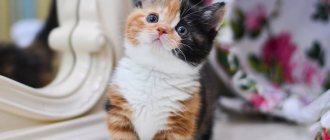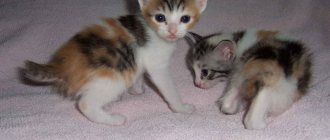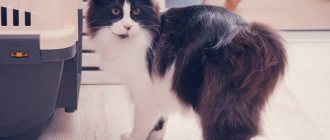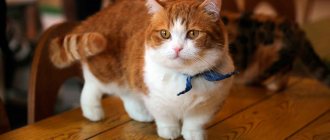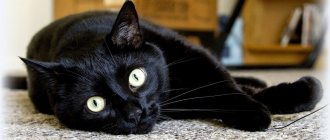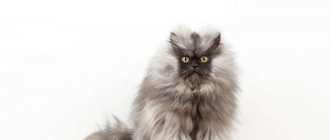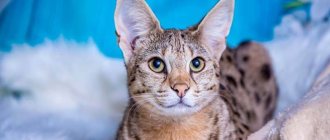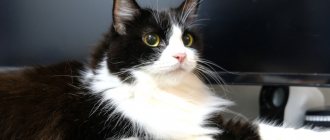Representatives of the Mekong or Thai Bobtail breed are true aristocrats among their brothers. They came to us from Asia. Ancient images have been preserved in which cats are dressed in the “decorations” of the Siamese princesses. They are similar in appearance to them in the dark color of the muzzle, but they differ from this breed - loops and kinks on the tail. The peculiarity of the animals is the similarity of their character with that of a dog: they walk on a leash, are easily taught commands and can fetch things in their teeth.
Story
The breed is one of the most ancient, and therefore there are legends and myths accompanying it.
One of them says that in ancient times beautiful princesses lived in Siamese temples and their pets were cats with broken tails and dark muzzles. While taking a bath, they took off their magnificent jewelry and put it on the tails of their guardians - Siamese with broken tails. And they took special care of their entrusted treasures.
Read a separate article about the Siamese cat breed, see their photos on our Mister Cat portal.
Representatives of this breed first came to European countries in 1884 from the capital of Siam with the poetic name City of Angels. They were brought to America several years later, and in Russia they appeared at the court of the emperor at the beginning of the 20th century.
Due to the broken tail in numerous knots, the breed was not recognized by felinologists in many countries for a long time and they were not allowed to participate in exhibitions, as this was considered a defect.
However, Russian breeders fell in love with the animals, and they made a lot of efforts to preserve the breed. At that time these animals were called Thai. By crossing the Mekong with other varieties of cats brought from Southeast Asia, it was possible to expand it.
In 1994, the Mekong standard was first adopted by the WCF, and in 2003, 30 individuals that differed significantly from the Thai Bobtail were submitted to the organization for evaluation. Based on the results, it was decided to separate these cats into a separate breed, which was called the Mekong Bobtail.
Brief history of the breed
The homeland of the Mekong is considered to be Southeast Asia, and their first description is found in Charles Darwin’s work “Change in Domestic Animals and Cultivated Plants,” dated 1883. Initially, they lived in temples and imperial palaces and were not exported outside the state for a long time.
Foreigners could only take possession of a Mekong cat as a valuable gift. The list of recipients included such famous personalities as British Ambassador Owen Gould, Nicholas II and the governess of the children of the ruler of Siam, Anna Crawford.
European felinologists learned about the Mekong in 1884. Cats of this breed came to the USA only in the 1890s. For a long time, the Mekong Bobtail was considered a variety of Siamese and was discarded due to its broken short tail. This anatomical feature was preserved only thanks to individual connoisseurs of Thai bobtails. After some time, experts noticed that Mekongs differ from Siamese not only in the length of their tail, but also in their build and set of ears.
Purposeful breeding of the breed began only in the 20th century. Russian felinologists played an important role in the development of the Mekong. In 1994, O. S. Mironova submitted the first breed standard for consideration at the WCF training camp in St. Petersburg.
The final registration of the Mekong Bobtail took place in 2004 at the August meeting of the WCF General Assembly, which was held in the German city of Essen.
Peculiarities
In the cat kingdom, each breed has its own flavor and unique characteristics:
- The most striking feature of the Mekong Bobtail breed is its tails. It is almost impossible to find individuals with two identical tails, exactly repeating the creases and sizes.
- The Mekongs are distinguished by their life expectancy - up to 25 years. With good care and maintenance, a cat can give birth to kittens even at 21 years of age. The officially registered life record is 38 years.
- The claws on the hind legs do not retract completely. When walking on a hard surface (wood, laminate), they make a characteristic clicking sound, reminiscent of a dog walking.
- This breed has absolute matriarchy. The Mekong Bobtail cat controls not only the offspring, but also the cats. They humbly accept her dominance, never allow themselves to snap at a slap from a lady, and patiently endure all “instructions.”
- When it's hot, the pads of your paws are the first to start sweating.
- Cats do not tolerate loud noise well; they try to leave the discomfort zone.
- In a fight, the teeth are the first to be used as weapons, and only then the claws.
- Children are raised by their “dad,” which is quite a rare occurrence in the animal world.
- These cats use their voice exclusively to communicate with people.
- The skin does not adhere tightly to the muscles, a large gap allows the animal to endure children's hugs painlessly.
Interesting Facts
During the existence of the Mekongs, many interesting things have been associated with them:
- For a long time, these cats were not considered a separate breed and were called Thai Bobtails. Later they were renamed the Mekong, which is the name of the river near which they lived.
- In the old days, bobtails were considered sacred and lived in Buddhist temples. According to one legend, when cats of this breed guarded ancient vases and figurines, they wrapped their tails around them and squinted their eyes strongly to see everything that was happening around them. Sitting in one position for a long time caused the Mekong's eyes to become slanted and its tail to bend.
- According to another legend, bobtails were the guards of Thai princesses and accompanied them on walks. When high-ranking persons wanted to swim, they hung the jewelry they had taken from themselves on the hooked tails of the Mekongs.
Breed description, standards, appearance
The Mekong Bobtail is a compact, harmoniously built cat with well-developed muscles and a short, broken tail. A detailed description of the breed is presented in the 2004 standard.
Dimensions and weight
The Mekong Bobtail is a medium-sized cat with pronounced sexual dimorphism. The breed standard suggests that the average weight of a female is 2.5-3 kg. The weight of a male Mekong fluctuates between 3.5-4 kg.
Anatomical characteristics
Ideally, the Thai Bobtail should fit the following description:
- The head is wedge-shaped, neat, with rounded outlines, an oval muzzle, a developed lower jaw and a strong chin.
- The ears are large, slightly tilted back, and set high. The gap between them is slightly less than the width of the base of the shell.
- The eyes are large, expressive, oval. The Mekong Bobtail's iris is pigmented blue.
- The body is rectangular, graceful, with developed muscles, a straight back and a slightly raised croup.
- The limbs are slender, moderately long, with small oval paws. The Mekong Bobtail does not hide the claws on its hind legs and walks with a characteristic clattering sound.
- The tail is short, with varying degrees of flexibility. Consists of a set of knots, loops and hooks. The shortest tail length of the Mekong Bobtail is 3 vertebrae, the maximum is limited to 1/4 of the length of the body.
The tail of each representative of the Mekong Bobtail breed is unique and has unique features. It can bend in any direction and consists of an individual combination of creases.
Depending on their appearance, Mekong tails are conventionally divided into the following types:
- stump - a very short tail, formed by fused vertebrae;
- spiral – vertebrae, the number of which does not exceed 15 pieces, are connected into a spiral;
- panicle – up to 10 vertebrae, broken at an obtuse angle;
- pushed back - straight tail of 7 vertebrae, ending with a hook.
Color and coat type
The body of the Mekong Bobtail is covered with shiny, close-fitting fur, under which there is practically no down. The cat's short, elastic and smooth spine feels like silk to the touch.
The Mekong Bobtail standard allows only color-point (Siamese) color without spots or patterns. The most common colors found in the breed are:
- Seal point. The Mekong Bobtail with this color has a cream-colored coat, and the tail, muzzle and paws are dark brown.
- Tabby point. There are clearly defined stripes on the tail, mask and paws of the Mekong, and on the cat’s face there is always a dark mark in the shape of the letter “M”.
- Torty point. This rare tortoiseshell color is characteristic only of females.
- Red point. This color is a combination of a white background with a delicate peach tint and fiery red markings.
- Blue point. The Blue Point Mekong Bobtail has bluish-pink markings on a silver background.
- Chocolate point. These Mekongs have chocolate brown markings on their snow-white fur.
Possible breed defects
Serious disadvantages that affect the show career of the Mekong Bobtail:
- thick cheeks;
- large and round eyes;
- pronounced cheekbones;
- thick undercoat;
- sharp stop.
Defects in the presence of which the Mekong Bobtail is excluded from participation in exhibitions and excluded from the breeding program:
- absence of knots, loops, hooks and curvatures on the tail;
- very short or too long tail.
Tail shape
The animal's tail is a source of pride for the owner of the Kurilian Bobtail
At exhibitions, all attention will be focused on him. Its shape is individual and unique
There are several types of Kuril Bobtail tails:
- "spiral". Visually, it reaches 5-10 cm in length. It consists of 3 to 15 vertebrae. They are badly broken in many places. Sometimes the fracture occurs at a very sharp angle. The junctions of the vertebrae are mobile or partially mobile;
- "panicle". Its length is 5-15 cm. It is formed by 5-10 vertebrae curved at obtuse angles. Their junctions are semi-movable;
- "stump". This tail most closely resembles a pompom. It is very short (2-5 cm). It consists of 2-8 vertebrae broken at obtuse angles, as if placed one on top of the other. They are connected motionlessly;
- “retracted bobtail” or “squiggle”. An interesting shape, in which a small part of the tail has a traditional structure (5-7 vertebrae at its base). The remaining vertebrae break at different angles along their entire length. The places of their connection can have any mobility.
Character and temperament
The Mekong Bobtail is a curious and outgoing cat. He accompanies his owners everywhere and takes part in all household chores. The talkative pet comments on everything that happens with purring and cooing sounds and loves to be addressed by name.
Despite being sociable, a cat of this breed is quite restrained and knows how to control itself, and does not tolerate too violent manifestations of emotions.
The Mekong Bobtail is very dog-like in character. He also loves to carry various objects in his teeth and always comes running to sniff the host’s guests. And in case of danger, the cat will defend itself not with its claws, but with the help of bites.
On a note. Mekongs tolerate car travel well. But when the “speed limit” they set is exceeded, the cats begin to protest loudly.
Mekongs get along well with children and are patient with their pranks. Cats are also loyal to other animals, with the exception of rodents, fish and birds.
Mekong Bobtail – owner reviews
Who can you trust to judge the breed if not the owners and connoisseurs of the Mekong Bobtail? For many people thinking about choosing a pet, reviews of cats are of great importance in making the final purchasing decision.
Personally, I think the Mekong is an excellent breed, and the reviews I picked up were positive (in principle, there were no very negative ones).
- Olga. Korolev.
We have known bobtails for a long time. My son turned 10 when we bought our first cat. How we loved her, and how she loved us. She followed us and slept next to us. Now my son is 25 and recently he bought a copy of our first Sonechka. It feels like Sonya has returned, just as affectionate, purring at her side, lying next to her. Do you know how she feels when she’s bad, she understands everything, we adore her. She recently gave birth, she has four kittens, she is caring, and now everything revolves around them.
- Marina. Saint Petersburg.
I bought the bobtail purely for myself, not for divorce. In fact, I even saved money on this. What can I say - smart, sociable, intelligent. So I adore him, but sometimes his loudness is out of place, but otherwise everything is fine.
These were reviews of the Mekong Bobtail breed. Maybe they will to some extent help you make a decision about buying a pet of this breed or, on the contrary, will make you think about your future choice. The point of publishing reviews is not to highlight the pros and cons of bobtails. The main thing is that people are interested in these cats and are ready to share their attitude towards them, which means that the breed definitely has a future.
How to choose the right kitten
The Mekong Bobtail is bred mainly by foreign breeders. Therefore, buying a purebred cat from an advertisement in a newspaper or at a poultry market is extremely problematic. It is better to look for a bobtail in a well-known nursery registered in one of the existing felinological systems.
When choosing a Mekong breed kitten, you need to pay attention to:
- for the availability of documents;
- conditions of detention;
- behavioral characteristics;
- health status.
Another important characteristic is compliance with the breed standard. A typical Mekong kitten should have:
- moderately long and dense limbs;
- fit, strong and well-fed body;
- nose with a slightly noticeable hump;
- textured head with a graceful oval muzzle;
- short tail with a break at the base.
On a note. Mekong Bobtail kittens are born completely white. After a few days, dark marks begin to appear on their body. And the final color in cats of this breed is formed only by 18-24 months.
Kitten care
Competent breeders do not separate Mekong Bobtail kittens from their mother before they are 3-4 months old. By this point, the kids become completely independent and adapt more easily to a new place. They can already use a scratching post, go to the litter box and eat solid food.
At first, Mekong kittens are fed what they are accustomed to from the breeder. To monitor their body's reaction, new foods are introduced into the diet in stages. The kittens' menu must include rabbit, veal, turkey, boiled eggs and low-fat cottage cheese. The number of feedings is calculated taking into account the age of small bobtails.
To ensure safety in the room where the Mekong kitten is kept, windows and balconies are not left open, electrical wires, ornamental plants, household chemicals and small items are removed.
Suit
For the Mekong, seal point is considered a classic color. It is the most stable of its type. The following colors are allowed: tortie and tabby varieties, cream, blue, chocolate, red, lilac, lynx. Breeders are working to develop lilac and gold shades.
The most common colors:
- Seal-point. The general background is cream, the mask and markings on the paws are black.
- Red-point. Rare color. Against the background of snow-white skin there is a fiery red mask and “gloves”. The main white color may slightly shimmer with a peach tint.
- Tortie-point. Nature rewards only cats with this tortoiseshell “outfit.”
- Blue-point. The body is covered with silver hair, the mask and the color of the legs are bluish or pink. Quite a rare color.
- Chocolite-point. The general background is cream or snow-white, the markings are chocolate-colored. The peculiarity of this suit is the lilac or purple tint of the eyes of animals.
- Tabby-point. On a white or lightly tinted background with tabby markings and a variety of lace patterns. A prerequisite is the presence of a mark in the form of the letter “M” on the muzzle. The accuracy and clarity of the drawing is valued.
Care and maintenance
Mekongs are clean and heat-loving cats. Caring for them is practically no different from caring for representatives of other short-haired breeds.
To ensure that the Mekong Bobtail always has a neat appearance, it is regularly subjected to hygiene procedures:
- The cat's ears are periodically inspected for the presence of uncharacteristic discharge and cleaned of dirt. To do this, wipe each of them with a napkin containing lotion that does not contain alcohol.
- Mekong claws are shortened with a nail clipper as they grow, and only the transparent tips are cut off.
- If tear tracks form in the corners of the cat's eyes, gently wipe them with a cotton pad moistened with boiled water, a decoction of herbs or a pharmaceutical solution.
- To prevent caries, the Mekong Bobtail's teeth are brushed 2-3 times a week with a soft brush and a small amount of special paste.
- In normal times, the Mekong is combed no more than 2-3 times a month. During the molting period, the procedure is carried out several times a week. A special glove is used for this.
- Bath your cat no more than 3-4 times a year using shampoos for short-haired breeds.
On a note. Instead of bathing the Mekong, you can simply wipe it with a special damp cloth.
Nutrition
If you decide to feed your cat regular food, do not add salt or seasonings to his food, take care of his kidneys. They benefit from boiled and raw boneless chicken, lean beef or pork, milk and offal. Some cats love raw and boiled liver. Sometimes cats prefer kefir instead of milk.
It happens that they like to feast on olives, give them only pitted ones, and no more than 2-3 per week. You can't give fish from the river, there are too many bones and salt there. We decided to pamper him with fish - boil the sea fish, separate it from the bones and offer it to your pet. Buy vitamins and other supplements at pet stores that will help your cat cope with hair loss and stool, and provide the required amount of fiber.
Dry food is healthier, all microelements are balanced, but you only need good premium food. And it's not cheap. In addition, it should not be taken simultaneously with natural food. Here you have to choose - either food or regular food. And don’t add any vitamins on your own, everything is in the food. The most important thing is to remember to give your cat water. Be sure to make sure the drinking bowl is clean and full of water.
Babies can be fed cottage cheese and kefir, and after 4 months, gradually switch to the adult menu. When walking with your Mekong, pay attention to what herbs he chooses to munch on. You can sometimes bring him a small bunch of blades of grass on your way home from work. Better yet, plant special grass for the cat.
There is a delicate moment in feeding a domestic predator - a mouse. These cats are good hunters, they catch mice and even rats. Teach your cat not to eat rodents, but simply to “smother” them. Someone could have already poisoned the mice, and your pet will accidentally suffer.
Feeding the cat
For normal development and functioning of the body, Mekong Bobtails require a balanced diet. If the cat’s diet consists of dry food, then it should be high-quality premium or super-premium products, which do not contain any questionable components. This can be food from the following brands:
- Royal Canin;
- Arden Grange;
- Bosch;
- Monge.
If the Mekong eats natural products, then fresh lean meat should predominate in its diet. Twice a week, a cat of this breed is given sea fish, boiled eggs and offal. The Mekong Bobtail menu also includes porridge, vegetables and fermented milk products.
To avoid problems with the digestive system, sausages, sweets, baked goods, seaweed, liver, potatoes, onions, pork, smoked meats, pickles, river fish and any food from the host’s table are completely excluded from the Mekong diet.
Education and physical activity
Thai Bobtails are active and jumping cats, they love hunting and walking. To maintain physical fitness, the Mekongs are equipped with a corner with tunnels, ladders and shelves on which they can climb. So that cats of this breed can realize their hunting instinct, they are given several interactive toys.
Mekongs are distinguished by high intelligence and good memory. They are easy to train and easily learn not only the rules of cat etiquette, but also remember different commands.
Health
The animals are in excellent health. Strong immunity guarantees long life. There are no special diseases specific to this breed. Taking care of your health does not cause problems. Vaccinations, protection against helminths, preventive examinations by veterinarians, and control over proper nutrition are needed.
Reasons for concern and contacting a specialist may include:
- poor appetite;
- inflamed and/or bleeding gums;
- bad breath;
- copious secretion of saliva.
Vaccinations and antiparasitic treatment
To protect the Mekong from viral and infectious diseases, it is regularly vaccinated against panleukopenia, calcivirosis, rhinotracheitis and rabies. The first vaccination for a Mekong kitten is given at the age of 7-8 weeks and repeated after 28 days. In the future, the pet is vaccinated annually.
To protect the Mekong Bobtail from diseases carried by fleas and helminths, it is regularly subjected to antiparasitic treatment. Protect your cat from fleas using special drops, collars and shampoos. Antihelminthic tablets are given to the Mekong Bobtail twice a year, repeated every 10-14 days.
Pros and cons of the breed
Before you decide to buy a Mekong Bobtail, you need to familiarize yourself with the main advantages and disadvantages of the breed:
| pros | Minuses |
| Pleasant exterior | Excessive jumping ability |
| Friendly character | Excessive talkativeness |
| High life expectancy |
The Mekong Bobtail is a cute cat with a characteristic Siamese coloring and an original hooked tail. Representatives of this breed are endowed with a non-aggressive, responsive disposition and will become excellent companions for those who dream of a sociable and cheerful pet.
